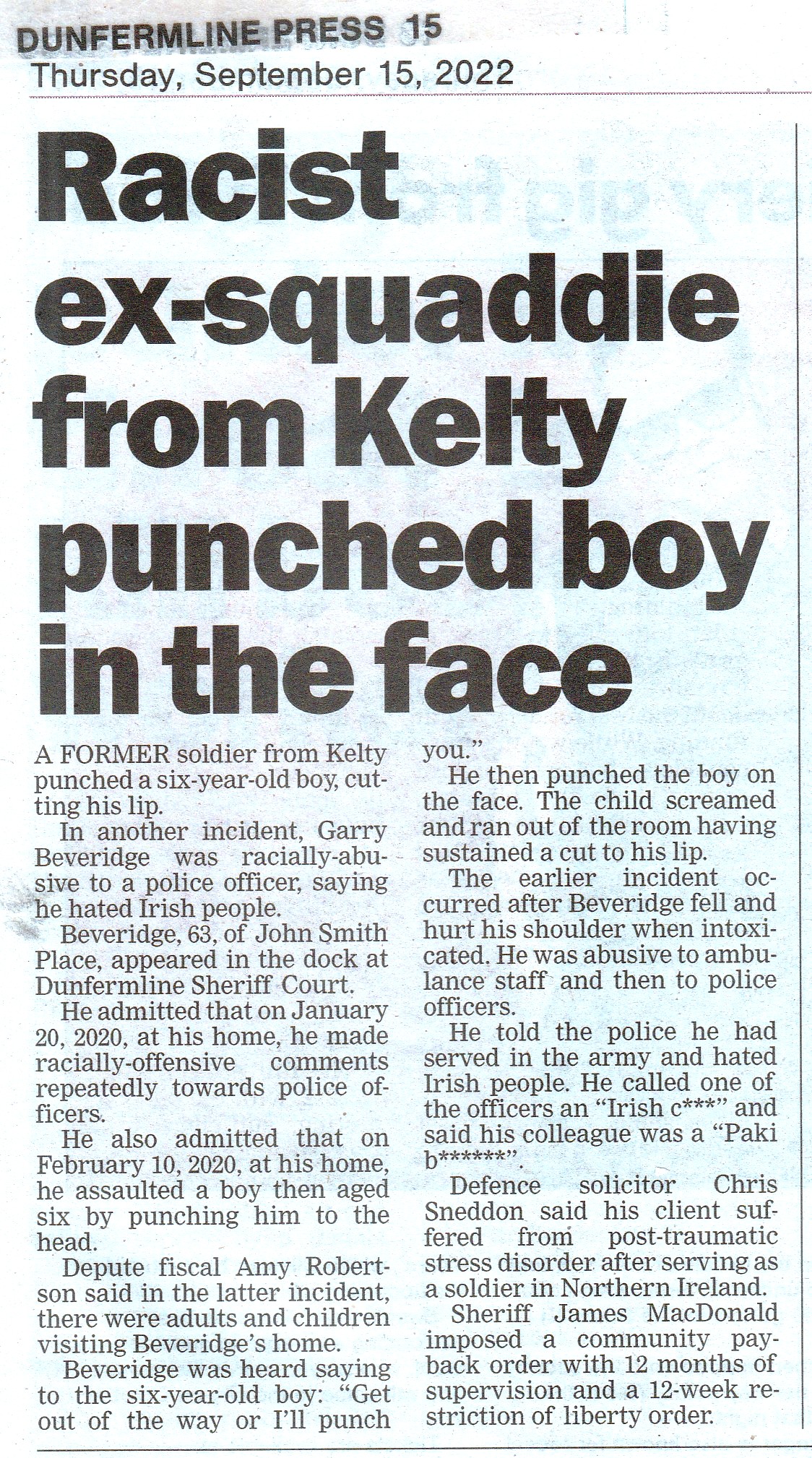1850 Riot Reflections based on my experiences.
This post looks at the common perception of Dunfermline and also my view of it based on my life experiences, as enlightened by my research into the 1850 riot, and seeking to draw lessons from both.
ANDREW CARNEGIE’S DUNFERMLINE 1835-1848
The general perception of Dunfermline as a town in the Victorian period is often generated from writings in connection with its prodigal son, Andrew Carnegie.
Carnegie wrote nostalgically about his ancient home town in his autobiography: –
“Fortunate in my ancestors I was supremely so in my birthplace. Where one is born is very important, for different surroundings and traditions appeal to and stimulate different latent tendencies in the child. Ruskin truly observes that every bright boy in Edinburgh is influenced by the sight of the Castle. So is the child of Dunfermline, by its noble Abbey, the Westminster of Scotland, founded early in the eleventh century (1070) by Malcolm Canmore and his Queen Margaret, Scotland’s patron saint. The ruins of the great monastery and of the Palace where kings were born still stand, and there, too, is Pittencrieff Glen, embracing Queen Margaret’s shrine and the ruins of King Malcolm’s Tower, with which the old ballad of “Sir Patrick Spens” begins:
“The King sits in Dunfermline tower, Drinking the bluid red wine.”
The tomb of The Bruce is in the center of the Abbey, Saint Margaret’s tomb is near, and many of the “royal folk” lie sleeping close around. Fortunate, indeed, the child who first sees the light in that romantic town.”
Of his early family life Carnegie was equally nostalgic. He wrote of how as a boy he crawled between the legs of a large crowd of weavers gathered at the Abbey Pend to see his father address a large outdoor meeting. Of how he was proud to say that he had an uncle (Tom Morrison) who “went to jail to vindicate the rights of public assembly.” And again how a different uncle, George Lauder was his idol, a man whose influence over him he said was: “inestimable”.
Anyone who has visited the historic quarter of the town described in this rosy reflection (written by the richest man in the world at the time), will recognise the idyllic picture he paints of the “romantic town”, but as we have now learned in earlier parts of this blog series, the Dunfermline of 1850 was a much more violent place than the one Carnegie described and the events that Carnegie’s uncles were involved in (particularly the petition to free the mob leader Black) weren’t the principled acts of the gentlemen that he recalled.
Carnegie was born in Dunfermline 25 Nov 1835 and left for America on 17 May 1848 aged 121/2 years.
TOM MINOGUE’S DUNFERMLINE 1948 – 2022
SCHOOLDAYS 1950-1960 Of course I have much more experience of life in the Burgh of Dunfermline than Andrew Carnegie had. I grew up from the age of four in Rosyth (a southern village that was part of the burgh), just off Castleandhill Road where the Irish were herded before entering the Royal Burgh of Inverkeithing.
My first marital home in 1970 was a flat in the “Gusset”, the junction between New Row, Netherton, and Bothwell St and my next home was in Baldridgeburn, both scenes of the 1850 Irish evictions.
My local pub for many years was the Bruce Tavern in Bruce St. scene of the Saturday night affray in 1850.
Today my favourite walk, which I try to do once a week, takes me to boyhood haunts on the Fife Coastal Path, from Cruickness to Carlin Knowes quarry where the Irish evictees were herded.
When I first read of the Irish evictions I walked the 10 kilometres from my home just off Townhill Road Dunfermline to North Queensferry and tried to imagine the horrors that the evicted Irish suffered on the same road, but also reflected on the many times I had walked this road in my youth. My memories were mostly very happy ones, but I also mused on the anti-Irish/RC nature of the area that didn’t leave with the navvies in 1850, and is still with us today.
If I were to write a truthful autobiography of my childhood in Rosyth, it would begin by recalling how as a young boy of nine or ten in the early 1950s I was confronted while bird-nesting in open countryside at the Bell-Knowes (on the route the Sheriff-substitute took in a droshky to overtake the mob) by a total stranger of my own age, who ran up to me thrusting his face into mine and shouting “lie down and grunt ya’ Fenian cunt!”
I was stunned and baffled by this rural racism. I was a Yorkshire-born orphan, the foster-son of a Sunderland couple and knew nothing of Ireland. But this young genealogist/thug was able to attribute Irish ancestry to me long before I ever knew of it, probably by dint of the RC school I attended, or perhaps my Irish surname. His interest in me (I had none in him) as an incomer to the village must have been driven by bigotry and I later found out he was from an Orange Order family.
My primary school at that time was St John & St Columba’s, which was sited adjacent to the RC church of that name at Rosyth crossroads.
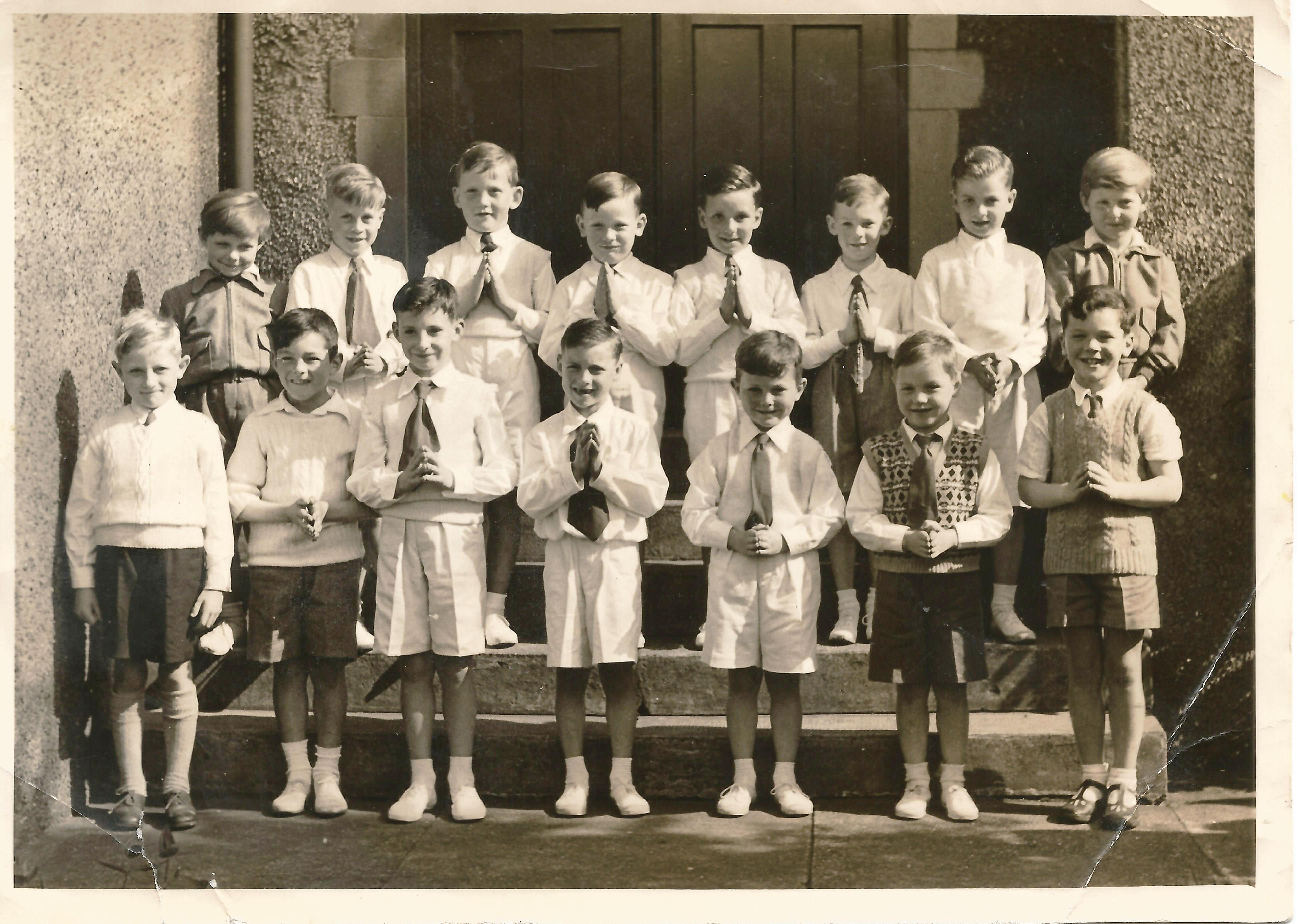
4th from Left, Back Row on my First Communion outside of St John & St Columba’s RC church Crossroads Place Rosyth
My secondary school was St Margaret’s Dunfermline up to a time in my thirteenth year when my foster parents took me out of it and put me to King’s Road School Rosyth. The reason for this move was, they said, to enhance my chances of getting an apprenticeship in HM Naval Dockyard Rosyth, as King’s Road had a good success record in the entrance exams for there.
I attended mass every Sunday and all holy days of obligation as my devout RC foster parents insisted on this, but as a known RC entering a Protestant school I didn’t experience any great hostility. Some few pupils made snide remarks and I perceived some hostility from one or two teachers, but most were fair and the ones that counted, the Head and the School Padre went out of their way to welcome me. The Padre said I didn’t have to attend assembly if I didn’t want to, but this didn’t bother me and I attended.
I was impressed by the Padre who was as approachable and down to earth as my parish priest was aloof and snobbish (an ex-British army officer). Some years later the Padre would show his Christianity wasn’t parochial when he wrote a damning criticism of Orangemen and Orangewomen in the local press.
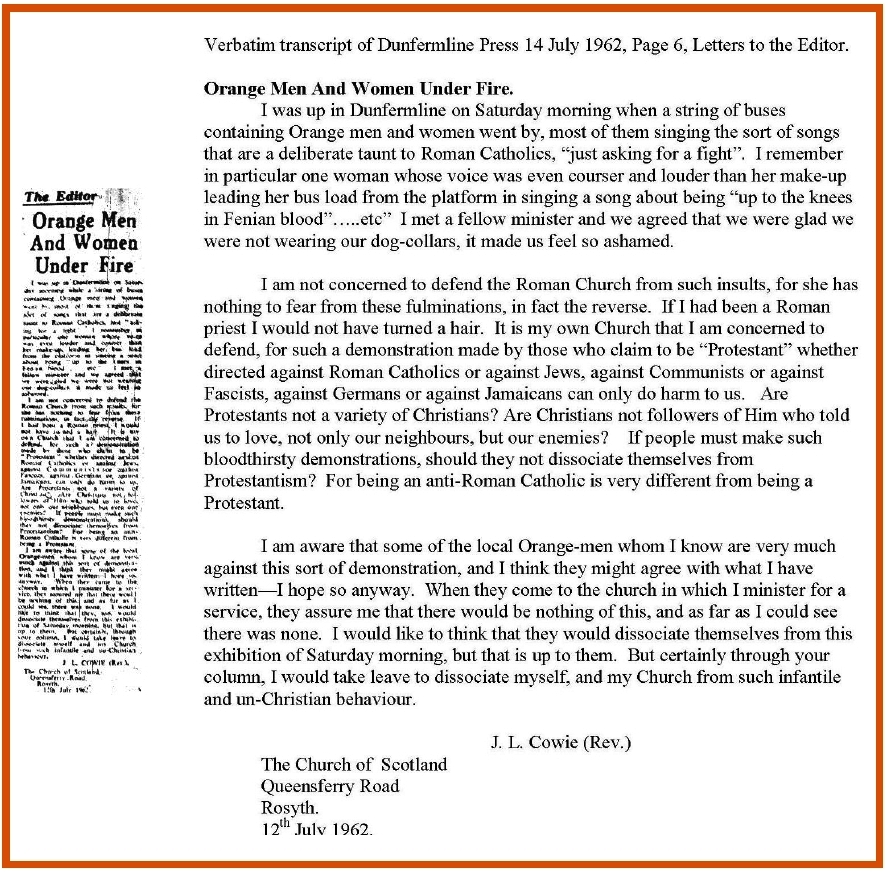
WHAT’S IN A NAME? During my years as a teenager working in the industrial setting of Rosyth Dockyard I became more aware of anti-Irish/RC sentiment, but it wasn’t anything I couldn’t handle. The banter was often quite barbed, but was mostly humorous and a two-way thing that normally centred on football.
However there were times, in social settings when drink had been taken, when I would be involved in heated arguments or even fist fights and no matter the subject that caused these, my adversary would often resort to calling me a Fenian in the heat of battle.
To be precise the word Fenian was never used on its own to describe me, but was usually prefixed or followed by an expletive. “Dirty Fenian bastard” being the most commonly used one. Such exclamations, when arguing or fighting over a dispute at cards/ /girlfriend/whose round it was/ snooker, were completely incongruous.
This puzzled me and being inquisitive or analytical by nature (as well as argumentative) I did a mental evaluation of it. I deduced that it was more about ethnicity than religion (an Italian RC wasn’t one) and concluded the use of the word Fenian was a synonym for Irish. I didn’t see how putting a Pogues record on the pub jukebox or my surname could be solely reference to Roman Catholicism, e.g. “who put that fucking Fenian music on?” or referring to my uncommon surname “is that a Fenian name?”
My theory that Fenian = Irish is just that, a theory, but I don’t think I’m too far off the mark, though it’s use wasn’t always used in an outright hostile manner and sometimes was masked with humour. e.g. on me making a mistake “he can’t help it he went to the Fenian school” or when I was arguing a point, “see what happens when you educate a Fenian?” There were other words used in this sort of banter such as “Catholics”, or simply, “Them”.
In short I found that I was pigeon-holed into a category that was not the mainstream, by being identified as Irish/Irish-descended and RC.
But whether Irish, Catholic, or Them when used in reference to me (as a mild almost friendly sobriquet to being or a prelude to violence) it invariably classified me as being other than 100% Scottish, which despite my place of birth I considered I was.
The best analogy I can think of is that my “Fenian” “RC” “Them” status was akin to that of my Honorary Membership of Rosyth Ex-Servicemen’s Club, which allowed me full use of all the facilities, but because I wasn’t an ex-serviceman I wasn’t allowed to vote in elections and this deficiency would always be used by Full Members to point-score.
So as far as being Scottish went, I felt I wasn’t a full Scot, rather an honorary one.
RELIGION AND MARRIAGE I met my future wife when I was about seventeen. She was a Towhill girl working in the office of the Cooperative Society in Dunfermline at the time and we had been going out casually for a few years when I took her home from the Kinema Ballroom Dunfermline on a night we’ll all remember, Friday the 22nd of November 1963, the night the news of the assassination of US President John Fitzgerald Kennedy broke.
The following day I attended a football match at East End Park, Dunfermline, where Rangers were the visitors. The chorus of boos and sectarian songs during the one minute’s silent tribute to the late president was shameful, though not unexpected from Rangers fans with their history of Orangeism (Rangers had a policy of not employing a RC that only ended in 1989).
But what disgusted me most at the match that day was the fact that many local Pars fans, my peers, joined in, and to make matters worse, this was studiously ignored by the mainstream media and only made the Letters columns of the local paper. Dunfermline Press Conduct of Rangers’ Supporters
A few years later in 1969, I married my sweetheart (now my wife of 52+ years), a Church of Scotland Protestant of purely Scots ancestry, in my local church, St. John & St. Columba’s Rosyth, situated where Queensferry Road joins Castleandhill Road where I lived (along the route which the Irish evictees were herded).
Just after we were married the church was vandalised and the altar wrecked and a few year later was daubed with offensive graffiti in white paint a metre high. I knew one of the 3 perpetrators, all young men, who were convicted of these sacrilegious acts and I knew two of their fathers who were Orange Order members.
Though the above incidents were hardly reported in the press the recent anti-RC bigotry and attacks on the priest and parishioners at Rosyth in 2017 have eventually made the BBC News, so progress of sorts I suppose, in reporting, at least. Priest and parishioners pelted with eggs outside Fife church
IS ANTI-IRISH RACISM/ANTI-RC BIGOTRY A SCOTTISH THING? From my experiences as a Scotsman, even though an honorary one as explained above, I have concluded that the bigotry I’ve experienced in my lifetime living in the UK is peculiarly Scottish in nature, if not exclusive to Scotland (I’ve never been to Northern Ireland).
My view on this is formed by observation and talking to my late siblings about their experiences. As explained I was orphaned at a young age and after a spell at a children’s home in Dewsbury, together with my older brother Joe, was fostered by my late mother’s brother. My two older sisters, Margaret and Elizabeth were fostered by my late father’s brother in London.
Despite the great distance that divided us, the Minogue siblings met once a year in the early days of our separation during the summer holidays at our Minogue, Irish, grandparents’ house in Knaresborough. Thereafter when working permitted we always managed to meet fairly regularly and maintain a strong family bond.
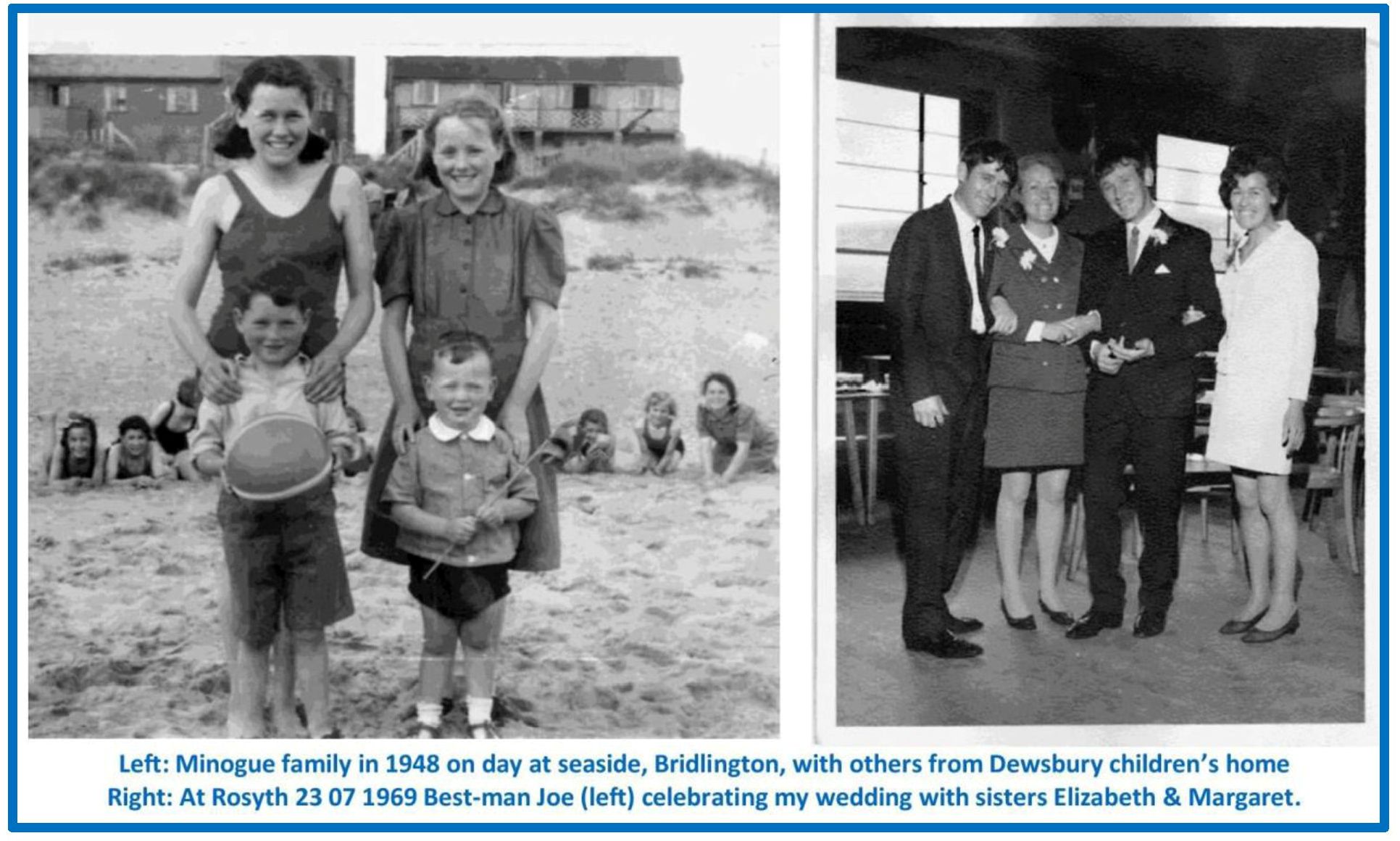 Both of my sisters were nurses and apart from Elizabeth having a spell abroad they lived and worked in England and Wales whereas apart from my spell in the merchant navy and his spell in Yorkshire my brother and I both lived and worked in Fife in the construction industry.
Both of my sisters were nurses and apart from Elizabeth having a spell abroad they lived and worked in England and Wales whereas apart from my spell in the merchant navy and his spell in Yorkshire my brother and I both lived and worked in Fife in the construction industry.
On one occasion when we gathered for some family event we got talking about anti-RC bigotry in Scotland and my very devout RC sisters were amazed and shocked to hear Joe and I swap negative experiences about this. They had no such experiences to tell of.
By contrast my brother and I, both lapsed RCs, had found anti-Irish racism and anti-RC bigotry a plenty in various situations in Scotland.
But there’s a sting in the tail of this tale, which came to light when my sister Elizabeth Whittaker died in 2006. When I sent for a copy of her will from the Probate Office, in an apparent alphabetic mix up they sent me the file of another W surname, that of a Joseph Douglas Wells, OBE a former RAMC Captain and doctor in Chelmsford who had died in 1957.
Reading this will I was disgusted to see that Dr. Wells had made it a condition of his will that his many beneficiaries would lose their bequests, shares, monies, etc., if they ever became members of the Roman Catholic Church and his Wife would have her annuity halved if she became Catholic. Will of Joseph Douglas Wells
So while Elizabeth said she didn’t experience anti-RC bigotry in England it was there, in the middle classes (and in one decorated by King George V in 1919 with the Most Excellent Order of The British Empire) as well, albeit not emblazoned on the chapel wall in Scots fashion, but gathering dust in an Essex lawyer’s office, hidden from public view.
As Wells carried his bigotry beyond the grave one wonders how he would have treated an Irish RC casualty in the Great War?
A QUEEN’S COUNSEL BRINGS BIGOTRY TO FIFE Some years after our family reunion my brother phoned and told me of how his regular Sunday morning ritual of a few drinks and a game of dominoes in his local club, Kelty Ex-Servicemen’s Club, had been ruined by friends telling him about Donald Findlay, QC, the speaker at the previous night’s Sportsman’s Dinner in the club.
These well meaning friends had rather tactlessly delighted in telling Joe about Findlay’s anti-Irish/anti-RC patter, which had been lapped up by the Kelty Hearts Prize-giving dinner attendees.
The normal attendees to the Kelty Hearts dinner were swelled that day by visiting Orangeman from Lanarkshire who had taken part in a walk with the local Kelty Oak Orange lodge in the village that morning, then spent the afternoon in the club watching a Scottish football international match.
Joe told me the village he had lived in for 40 years and considered it to be the best wee place in the world would never be the same to him again. What made it worse was that Joe felt part of Kelty Hearts, he had played an active part in the work that enabled Kelty Hearts to obtain junior status, and my engineering company were once their sponsors. With a pride in his ancestry Joe was disgusted that his friends were mocking him and the likes of him behind his back.
To establish the veracity of what my brother had been told I phoned Councillor Jim Brennan, the Fife Council Sports Convener, who had presented the prizes at the dinner to check out Joe’s second hand reports. Jim an Irish descended RC and a friend of mine said “Tommy I had the meal and presented the prizes then cleared out as I knew what to expect with Findlay as speaker”. Out of respect for my brother who was a quiet, sensitive, gentle man and didn’t want any fuss I let the matter rest for the time being.
Sadly Joe died in late 2004 and the following year I read of Donald Findlay QC, the after-dinner speaker who had caused him so much heartache, rabble rousing with Rangers’ goalkeeper Andy Goram in Larne, Northern Ireland. To show my disgust I posted an article on the “Dunfermline Town” website in my own name relating the event in Kelty.
I called my post “Bigotry in Fife”. Bigotry in Fife Dunfermline Web Portal
No longer constrained by respect for my brother’s privacy I complained to the British Legion about allowing divisive events in premises they regulated and still angry about the hurt Findlay had caused my brother I wrote a rather intemperate letter of complaint to the Faculty of Advocates about Findlay’s conduct.
I reasoned that what Findlay had done in Kelty had caused much angst, hurt, and division, but it hadn’t killed anybody, whereas what he was doing in the most troubled town in Northern Ireland might. I also criticised the Faculty from dealing with him so lightly in the past for similar acts.
The Dean of the Faculty advised me that my complaint was not in the proper format and Findlay objected to it on the grounds I was a serial complainer with no right to complain.
So, as a frequent user of the services of the Faculty of Advocates, I raised a new, formal complaint, apologising to the Dean and Findlay for my earlier one, and clarifying my status as a long time user of the Faculty’s services, and reiterating my disgust at Findlay’s conduct in Larne, which caused me to doubt the impartiality of the Faculty’s services. This time as well as citing my brother’s case I detailed several other examples of Findlay’s reported conduct that brought the Faculty into disrepute in a Moorov doctrine way, together with supporting documentation. Complaint to Dean of Faculty re conduct of Donald Findlay QC
After some exchanges a Complaints Committee chaired by Stephen (Now a law lord) Woolman, QC, upheld my complaint and agreed that Findlay had brought the Faculty into disrepute and they wished to remit the matter to the Faculty’s Disciplinary Tribunal to deal with the issue of penalty, but this required Findlay’s consent. Findlay guilty of bringing the Faculty into disrepute.
Rule 5 (7)(d) of the archaic and arcane rules that governed complaints against advocates in 2005 gave Findlay the option of accepting the findings of the Complaints Committee and have punishment imposed by a Disciplinary Tribunal, or rejecting them and having a new hearing before a Disciplinary Tribunal. Faculty of Advocates Disciplinary Rules 2005
5(7) (d) with the consent of the member, uphold the complaint in whole
or in part and remit it to the Disciplinary Tribunal for the
imposition of one or more of the penalties set out in rule 11
below; or
(e) remit the complaint to the Disciplinary Tribunal for
determination and disposal.
This option, in effect gave Findlay the chance of a second trial if he refused to accept the findings of the Complaints Committee, which of course he did.
Consequently a new complaint was drawn up against Findlay by the Faculty’s Counsel, Graham Bell QC, for determination and disposal by a Disciplinary Tribunal. Faculty Complaint against Donald Russell Findlay QC
This new complaint set an impossibly high bar for the Faculty to clear, in that they had to prove that “a significant section of the community” found Findlay’s behaviour offensive.
I don’t believe The Faculty wanted to win their case against one of their own, and were simply going through the motions. They proposed bringing a wide range of witnesses to support their main contention of “a significant section of the community“, including a famous journalist/author from Washington DC and a Mirror journalist from London, but in the event only me and a man from Larbert were called.
From the time of the drafting of a new complaint I ceased to have an active role in the process, other than giving a precognition to the Faculty Solicitor and agreeing to appear as a witness and speak to my original complaint, which was now defunct. Precognition
At the Disciplinary Tribunal Findlay was represented by Paul McBride, QC, and I wasn’t surprised when the Chair, a former High Court judge, Lord Coulsfield, pronounced Findlay not guilty of having offended a majority of the people in Scotland (the terms of the Faculty Prosecutor, Graham Bell QC’s oral argument), whereas my complaint was made and upheld by the Complaints Committee on the basis that he had offended one Faculty of Advocates customer, who no longer had confidence in the Faculty…….me!
It seems that the Disciplinary Tribunal had in effect ruled that any public behaviour is acceptable for Her Majesty’s Queen’s Counsel, as long as it doesn’t offend “a significant section of the community”.
Newspaper reports of the Tribunal stated that Findlay offered me an “unreserved apology”, but I was at the hearing and didn’t hear any such apology there, nor have I heard one since. Donald Findlay cleared of offensive joke charge
So apparently Roman Catholics, or Irish, and those of Irish descent are an insignificant section of Scotland’s multi-ethnic family, fair game as the butt of jokes. All very harmless you may think, but I know from the case of my brother that the harm done by the normalising, this ‘othering’, of Irish descended RCs can be immeasurable.
WHY HAS HISTORIC ANTI-IRISH RACISM ENDURED IN DUNFERMLINE, FIFE, SCOTLAND? Why is it that the anti-Irish/RC sentiment which flourished in Dunfermline, Fife, Scotland up to the time of the 1850 riots has continued to blight our town since then?
I have done some research into this question and believe it was propagated to some extent by the established church and some of their ministers like The Rev. Jacob Primmer (1842–1914), a bigoted parish minister in Townhill, who was hugely popular (His son was a councillor in Cowdenbeath where a street bears his name to this day), preaching to massive crowds in Dunfermline and Cowdenbeath (I likened Findlay’s after-dinner patter to Primmer’s in my Faculty complaint). To this day some Townhill residents still fondly refer to their parish church as “The Old Primmer”.
Primmer’s main theme was rants against RCs and the Irish which can be found in his writings that include such literary gems as “Which is the Greater Evil – Rome or Rum? – And the Cure for Both”, and “Pastor Jacob Primmer in Rome”. The ‘racially inferior’ Irish were characterised as lazy, criminal, drunkards who practiced idolatry in a religion headed by a Pope who was the anti-Christ personified.
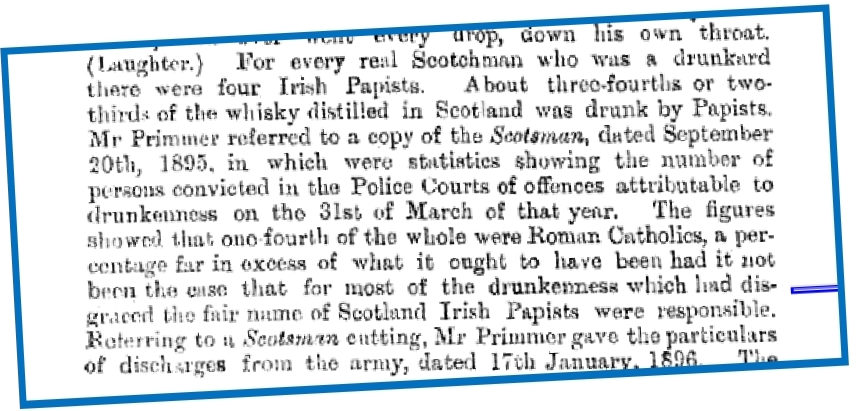
Primmer fell foul of the Church of Scotland on doctrinal grounds, but was not reprimanded for his books’ bigoted views. Not surprising really, as his views on this were in the mainstream, as evidenced by the 1922 Presbytery resolution to the General Assembly of the Church of Scotland calling for the expulsion of the Irish who they thought were diluting the purity of Scots blood.
The church’s eventual, but welcome apology for what it called “racism akin to Enoch Powell’s, Rivers of Blood speech”, when it came in 2002, was as brief as it was belated. Church of Scotland The Demon in our Society
While the established church must shoulder some blame, I believe another, and probably the main cause fuelling historic anti-Irish racism and anti-RC bigotry to this day is the Orange Order.
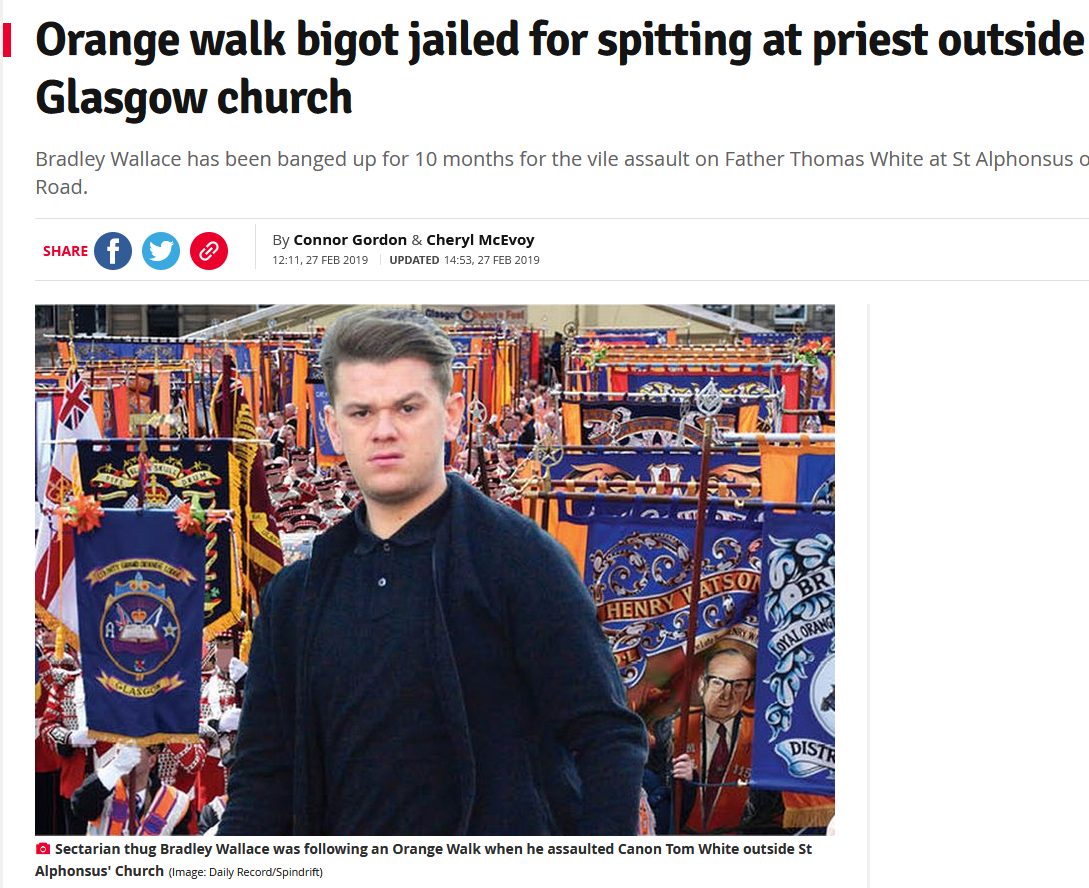
Confirmation of my belief in this was literally brought home to my front door one Saturday morning a few years back as I relaxed in the front room of my house in a quiet terrace in Dunfermline. Suddenly my peace was shattered by the booming beat of a Lambeg drum from a flute band escorting a parade of Orangemen/Apprentice Boys from Townhill, with guests from a Merseyside lodge, on their way to join a major walk.
This parade was led by the same man who refused me sight of the Masonic records of the St. John’s Lodge of Dunfermline, held in the Carnegie Library.
I understand the pride an Orangeman has in the sash his father wore. Respect for our ancestors is a noble sentiment. What I don’t get is how an anachronistic organisation that feared a Popish plot to dominate them in days of yore can endure for centuries after the threat is no more.
The hundreds (thousands?) of all year round Orange walks in Scotland to me are simply displays of triumphalism by those of a superiority mind-set. They are hugely damaging, and leave a trail of bitterness, division and often bloodshed in their wake.
Wouldn’t it be a good thing if, like the Church of Scotland did, the Orange Order apologised for their past bigotry, dropped RC bans and celebrated their heritage once a year? If they did they’d go from pariah to popular.
Another recent incident, that tells me that bigotry is alive and well in Dunfermline was when Dunfermline Athletic FC travelled to Celtic Park in a League Cup tie in August 2019 and a section of their fans, seated next to the family enclosure, kept up chants about Celtic (a team with strong connections to Ireland and having a strong support from the Roman Catholic community) being involved in paedophilia, connected with Jimmy Savile, the manager being a sad Fenian bastard, only signing in the chapel etc.
Like the events at East End Park in 1963, none of this was reported in the mainstream media, but was well reported on social media by reputable sources.
UPDATE 26/04/22 Reports in the press of stickers with the logo “ATAT”, an acronym for All Taigs Are Targets (Taigs being a derogatory term for RCs in Northern Ireland) set in a sniper rifle cross-hair sight, have been posted in Dunfermline public park. LINK
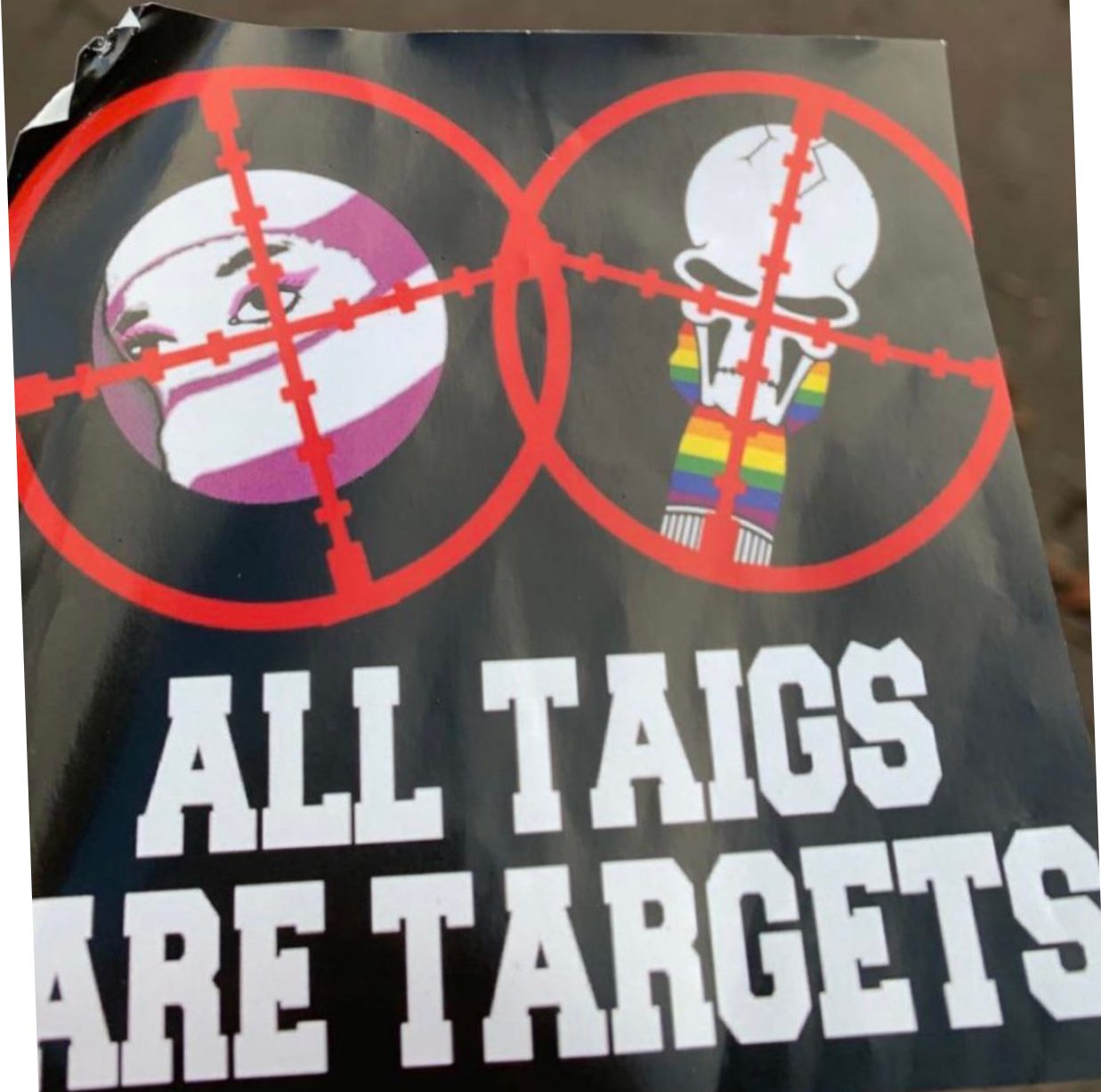
TIME TO SET THE RECORD STRAIGHT ON DUNFERMLINE’S ANTI-IRISH RACISM & ANTI-RC BIGOTRY? Today a history researcher looking into Dunfermline’s past would find much about the Meal Riots in the late 18th century and the Weavers’ Riots in the first half of the 19th century, but little about the ethnic cleansing of the Irish in 1850.
One exception to this omission (or Omerta?) being Alexander Stewart in his 1899 Reminiscences of Dunfermline. But rather worse than the Omerta is the current state of play.
The most recently published article on Dunfermline’s past in the “Scottish Local History Journal”, of 2008, is by a Carnegie Dunfermline Central librarian, Chris Neale, which re-writes history to give Dunfermline’s anti-Irish character a whitewash.
In Neale’s, otherwise good piece, which “looks at some instances of violence on the streets of Dunfermline in the 1840s” he provides much detail about the town’s riotous history and trouble between the locals, their employers, and the troops stationed there to keep order in the 1840s, but little (57 words from 5,509) about the ethnic cleansing of the Irish in 1850.
And to make matters worse his cameo errs in stating that the Irishmen killed a young native weaver, when in fact the opposite was the case. I Predict a Riot
In fairness to the author, when I pointed this out to him he did admit his error and apologise for it, he also excused his lack of a citation for his erroneous claim stating that in his “own discussion of the “Irish” events” he treated them “as something of a coda to the turmoil of the 1840”.
Though some would like to downplay them, these anti-Irish events were certainly not trivial, to be used as a book end. In fact they were by far the most violent of all the Dunfermline riots. They involved mass brutality towards all Irish born citizens, as opposed to the singling out of individual factory owners, or scabs (strike breakers) and their premises.
It’s as if today’s history books either overlook the Irish evictions of 1850 or are being written with a revisionist agenda that relegates the major ethnic cleansing of 1850 to a minor skirmish on the part of the locals against a murderous Irish mob.
This echoes the newspapers of 1851 reporting the trial, which was described as the Irish Navvy riots, at which no native inhabitants were found guilty of assault and housebreaking (as distinct from mobbing and rioting), thus trivialising their crimes.
I think there is a need to set the record straight, and hope that this blog on the 1850 ethnic cleansing of the Irish RCs from Dunfermline will go some way towards this.
THE WAY FORWARD My subject matter is a negative one and may cause distress to the good people of Dunfermline who have no bias against their fellow, Irish descended or RC citizens, but they should take heart from some redeeming features in what is generally a sorry tale.
Some native Scots, like the weavers who bravely stood up to the mob to protect their Irish workmates, the Sheriff-Substitute, Charles Shirreff, Procurator Fiscal, John Macdonald and Inverkeithing’s Provost James Spittal, who recognised the injustice of the cruel expulsion of their fellow citizens and with the help of the Queensferry quarrymen put a stop to it, were exemplary. These were good people and should be lauded for their actions.
My firm belief is that the vast majority of Scots today are like them, and have moved with the times, but there are still a sizeable minority who have inherited their forefather’s anti-Irish/RC bias. They are the ones who are likely to applaud, if not take part in, the annual Orange Order parades in Dunfermline.
Parades that you won’t see advertised on any tourist information websites, nor will you read much about them in the newspapers. Like the Irish evictions of the past we don’t like to talk about them!
To me, this exemplifies the hypocrisy whereby we Scots don’t record our own faults and present a “wha’s like us”, tolerant, facade to the world, and are quick to condemn racism in others.
Recently however there has been a welcome and honest reappraisal of Scotland’s past ills, in particular the profits Scots made in the West Indies and the Americas from plantations using slave labour, which brought so much prosperity to our country. Plaques explaining the true story of how previously venerated Scots came by their wealth are now becoming commonplace.
The Black Lives Matter campaign has also seen progress in matters of racial discrimination, but this Glasnost doesn’t seem to have extended to reach the Irish/Irish Scots. But surely, Irish lives matter too?
I firmly believe that until we honestly examine our past faults as well as the present ones, we will see a continuation of the anti-Irish racism/anti-RC bigotry, which apologists often excuse as sectarianism limited to football, but which is in fact Scotland’s dirty little secret, one that permeates all levels of society.
A MEMORIAL? While examples of the workmanship of the Irish navvies who built the Stirling and Dunfermline railway still stand today in mute testimony of their skills, there is no memorial to those Irish who suffered, such as the old pedlar Peter Kelly who died following the events of 1850.
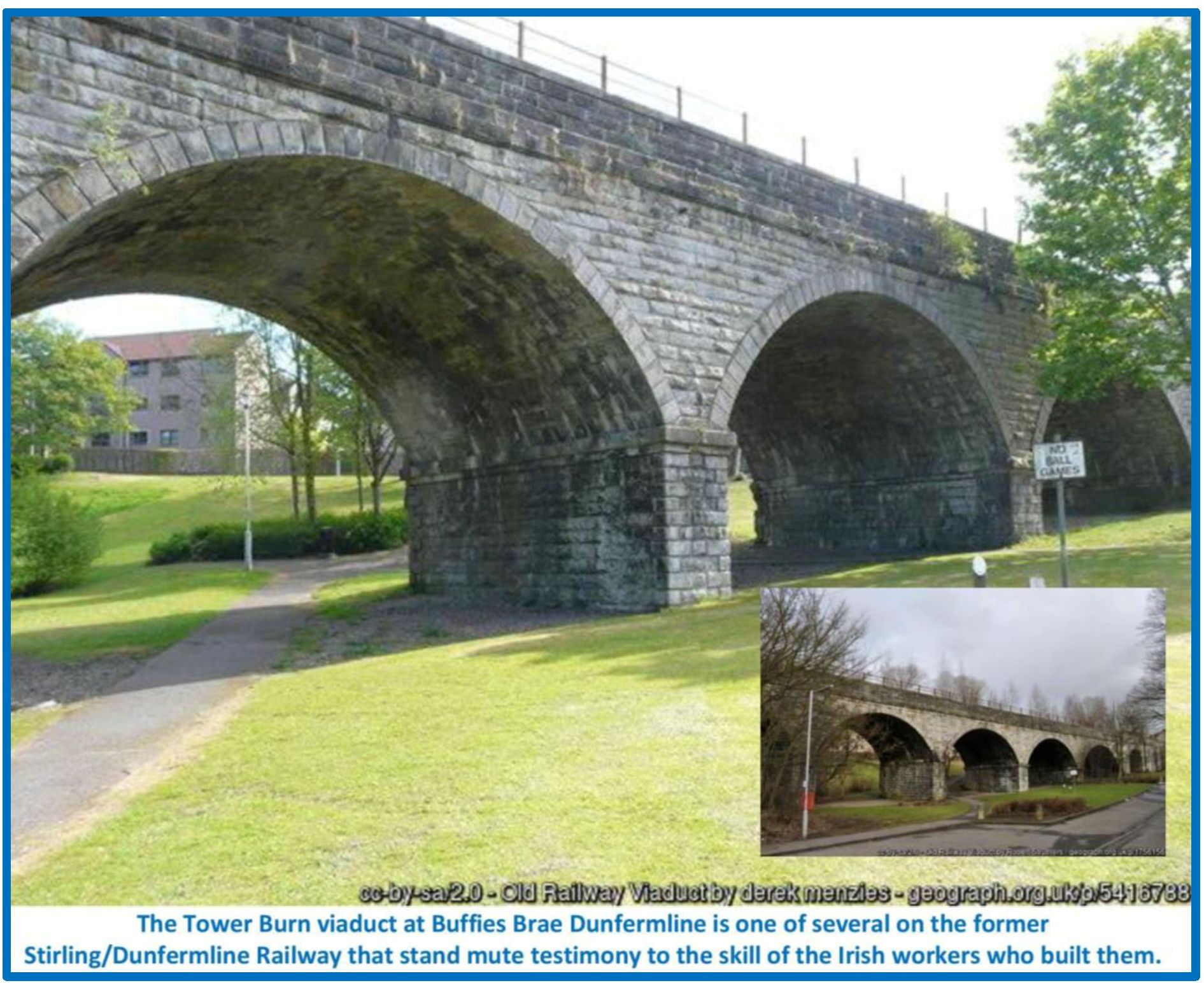
I think it’s time to put matters right and to that end I have petitioned Fife Council to have a plaque erected at Carlin Knowes Quarry on the Fife Coastal Path to mark the vile and violent expulsion of the decent Irish families who were forced from their Dunfermline homes and corralled there, and the honourable local officials who, with the help of the Queensferry quarrymen, put an end to it. Letter to Steven Grimmond re memorial.
Such a memorial is desirable and the location appropriate as it would mark the start point of the journey from North Queensferry back to Dunfermline taken by the evicted, beaten, weary, Irish immigrants. This journey took them on the same road walked by another immigrant, the Hungarian born, Saxon Princess, Margaret of Wessex (Later Queen of Scotland then Saint Margaret) in 1068.
Margaret’s journey is commemorated by St. Margaret’s Stone at a spot just south of Dunfermline where she was reputed to have taken a rest. Wouldn’t it be fitting to commemorate the Irish evictees at the other end of the road in North Queensferry, a town named after Queen Margaret who established a ferry there?
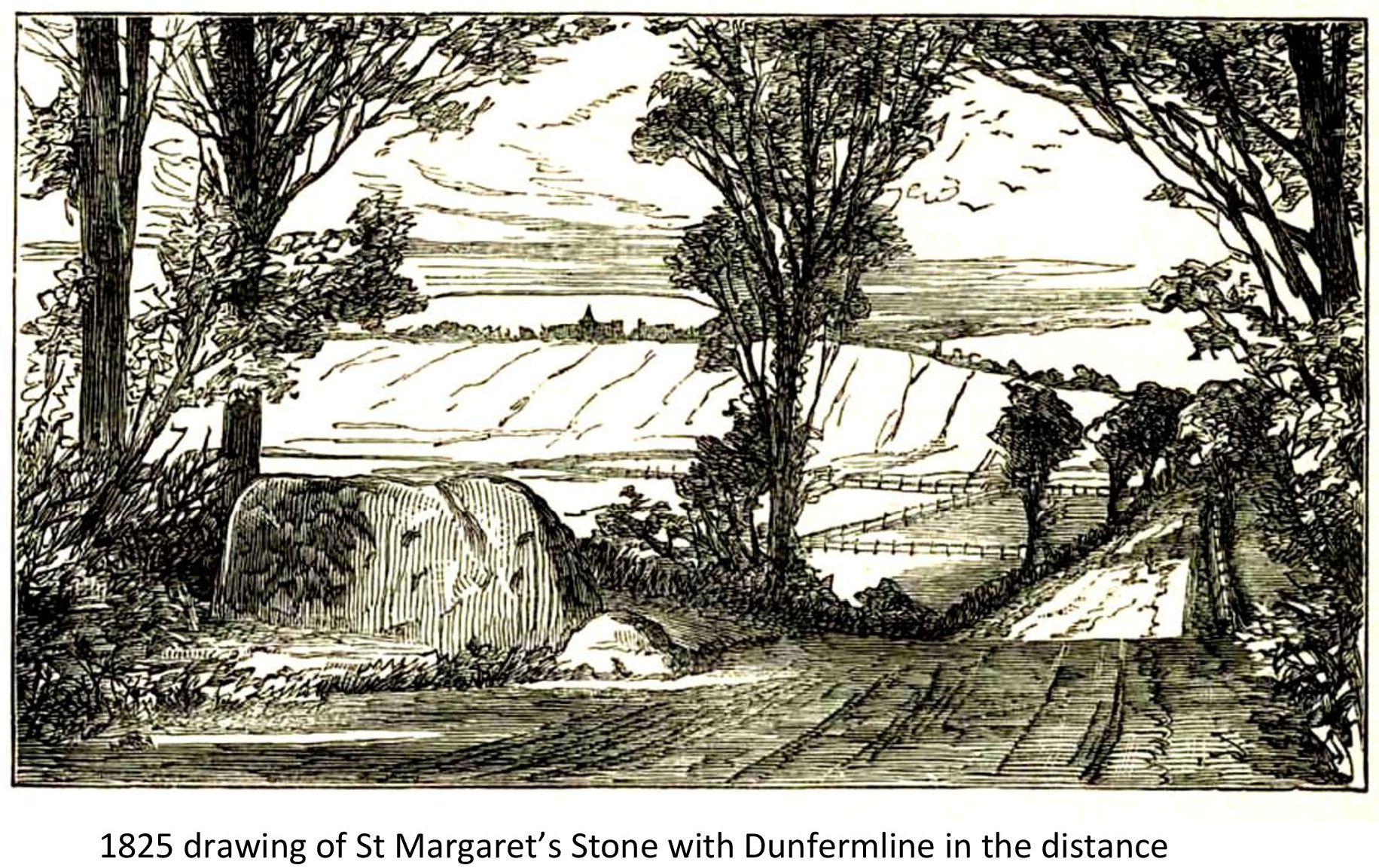
UPDATE 07/07/2022
I changed my mind about the location and aims of a memorial plaque since contacting local groups and realise that the events of 1850 had two phases, the evictions in Dunfermline and the halting of them in North Queensferry and these events deserve separate memorials. One at Queensferry and one at Dunfermline.
North Queensferry’s Community Council shared this view and at their 2022 AGM voted by 3-2 in favour of having a memorial there and I am pleased to say that a few weeks ago I purchased and fixed the sign shown below on a large boulder on the Forth Coastal Path at Carlin Knowes Quarry.
I still hold out hope that the Dunfermline Memorial might be erected at the Tower Burn Viaduct at Buffies Brae. Watch this space!
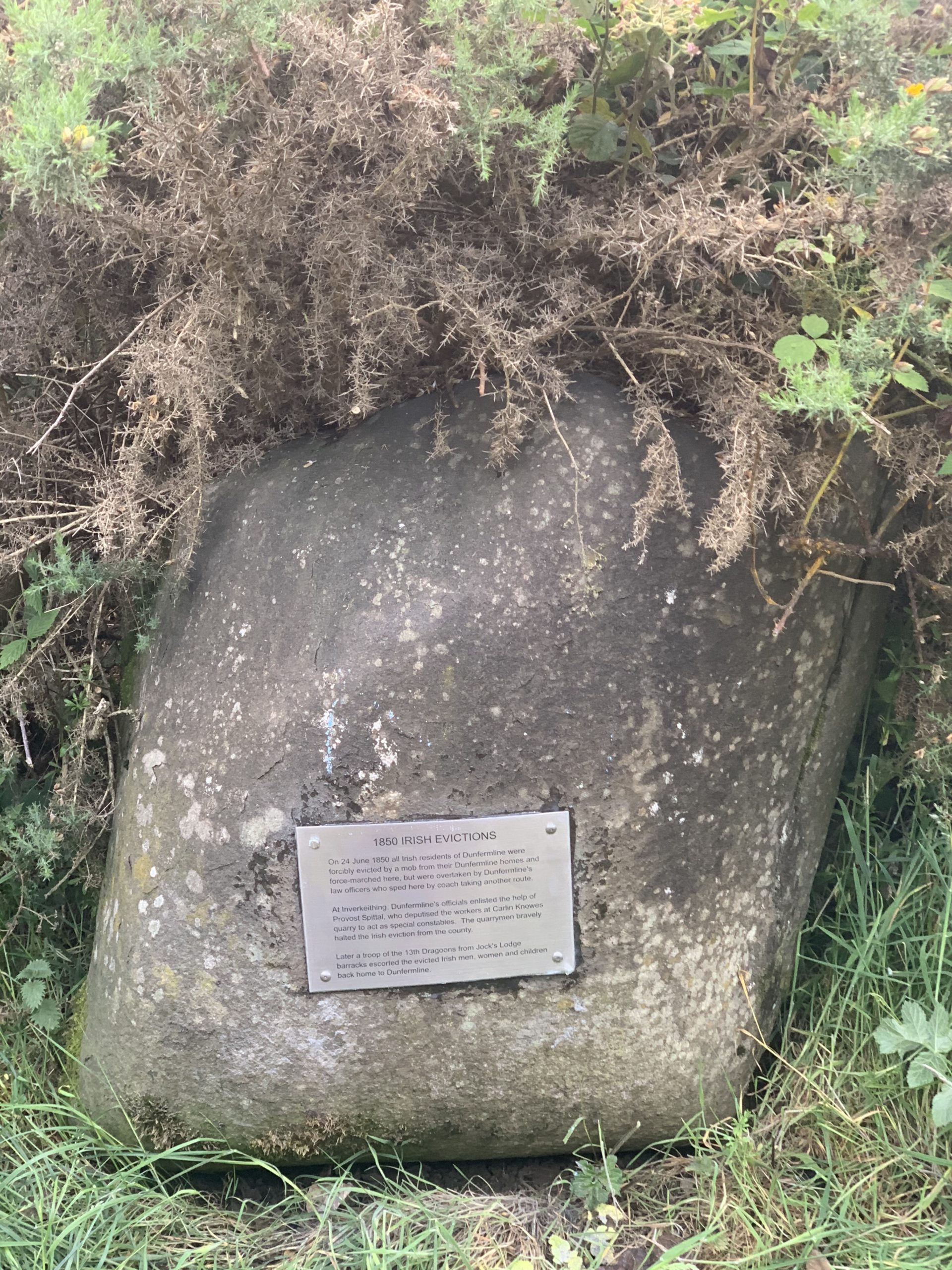
UPDATE 20/09/2022
The anti-Irish sentiment that caused the booing of the Minute’s Silence for JFK in 1963 still exists in Dunfermline some 59 years later as evidenced by the anti-Irish race hate outpourings of an ex-squaddie who had served in Northern Ireland and was sentenced to community payback last week (See photo).
This rather supports my belief that much of the anti-Irish racism present in Dunfermline has it’s genesis in Scottish regiments stationed in Northern Ireland.
